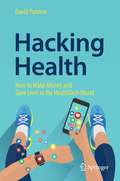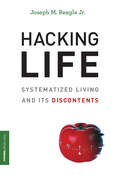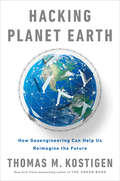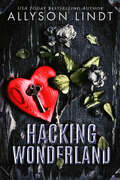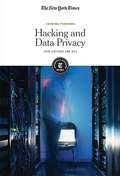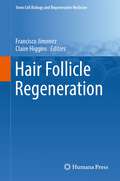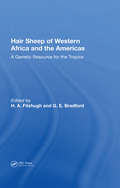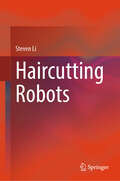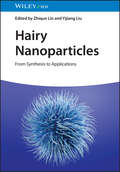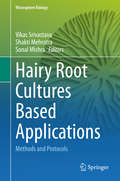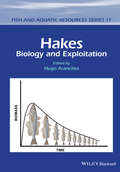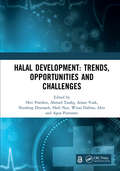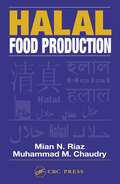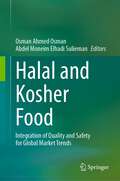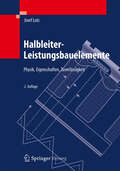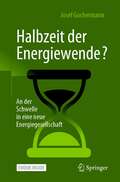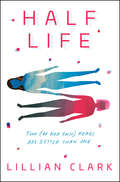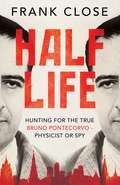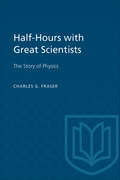- Table View
- List View
Hacking Exposed Wireless: Wireless Security Secrets & Solutions,Third Edition
by Joshua Wright Johnny CacheHacking Exposed Wireless, Third Edition features expert coverage of ever-expanding threats that affect leading-edge technologies, including Bluetooth Low Energy, Software Defined Radio (SDR), ZigBee, and Z-Wave.
Hacking Happiness
by John HavensIn Hacking Happiness, futurist and contributing Mashable writer John C. Havens introduces you to your "quantified self"--your digital identity represented by gigabytes of data produced from tracking your activities on your smartphone and computer. Harvested by megacorporations such as Google, Facebook, and Amazon, Havens argues that companies gather this data because of its immense economic value, encouraging a culture of "sharing" as they hoard the information based on our lives for private monetary gain. But there's an alternative to this digital dystopia. Emerging technologies will help us reclaim this valuable data for ourselves, so we can directly profit from the insights linked to our quantified selves. At the same time, sensors in smartphones and wearable devices will help us track our emotions to improve our well-being based on the science of positive psychology. Havens proposes that these trends will lead to new economic policies that redefine the meaning of "wealth," allowing governments to create policy focused on purpose rather than productivity. An issues book highlighting the benefits of an examined life in the digital world, this timely work takes the trepidation out of the technological renaissance and illustrates how the fruits of the Information Age can improve our lives for a happier humanity.
Hacking Health: How to Make Money and Save Lives in the HealthTech World
by David PutrinoThis book is a must-read guide for those entering the world of HealthTech startups. Author David Putrino, a veteran in the world of HealthTech and Telemedicine, details the roles, necessity, and values of key members of a typical HealthTech team, and helps readers understand the motivations and core priorities of all people involved. In ventures that typically depend upon effective communication between members from business, science, regulatory, and academic backgrounds, this book helps develop the core competencies that team members need to work harmoniously. Four detailed case studies are shared that exemplify the spectrum of HealthTech possibilities, including large corporations, tiny startups, elite athletes, and social good enterprises. Each case study shows how the success or failure of a project can hinge upon strong team dynamics, a deep understanding of the target population's needs and a strong awareness of each team member’s long-term goals. This book is essential reading for entrepreneurs, scientists, clinicians, marketing and sales professionals, and all those looking to create new and previously unimagined possibilities for improving the lives of people everywhere.
Hacking ISIS: How to Destroy the Cyber Jihad
by Malcolm Nance Christopher SampsonThis book is written by two of the leading terrorist experts in the world - Malcolm Nance, NBC News/MSNBC terrorism analyst and Christopher Sampson, cyber-terrorist expert. Malcolm Nance is a 35 year practitioner in Middle East Special Operations and terrorism intelligence activities. Chris Sampson is the terrorism media and cyber warfare expert for the Terror Asymmetric Project and has spent 15 years collecting and exploiting terrorism media. For two years, their Terror Asymmetrics Project has been attacking and exploiting intelligence found on ISIS Dark Web operations.Hacking ISIS will explain and illustrate in graphic detail how ISIS produces religious cultism, recruits vulnerable young people of all religions and nationalities and disseminates their brutal social media to the world.More, the book will map out the cyberspace level tactics on how ISIS spreads its terrifying content, how it distributes tens of thousands of pieces of propaganda daily and is winning the battle in Cyberspace and how to stop it in its tracks.Hacking ISIS is uniquely positioned to give an insider’s view into how this group spreads its ideology and brainwashes tens of thousands of followers to join the cult that is the Islamic State and how average computer users can engage in the removal of ISIS from the internet.
Hacking Life: Systematized Living and Its Discontents (Strong Ideas)
by Joseph M. ReagleIn an effort to keep up with a world of too much, life hackers sometimes risk going too far.Life hackers track and analyze the food they eat, the hours they sleep, the money they spend, and how they're feeling on any given day. They share tips on the most efficient ways to tie shoelaces and load the dishwasher; they employ a tomato-shaped kitchen timer as a time-management tool.They see everything as a system composed of parts that can be decomposed and recomposed, with algorithmic rules that can be understood, optimized, and subverted. In Hacking Life, Joseph Reagle examines these attempts to systematize living and finds that they are the latest in a long series of self-improvement methods. Life hacking, he writes, is self-help for the digital age's creative class.Reagle chronicles the history of life hacking, from Benjamin Franklin's Poor Richard's Almanack through Stephen Covey's 7 Habits of Highly Effective People and Timothy Ferriss's The 4-Hour Workweek. He describes personal outsourcing, polyphasic sleep, the quantified self movement, and hacks for pickup artists. Life hacks can be useful, useless, and sometimes harmful (for example, if you treat others as cogs in your machine). Life hacks have strengths and weaknesses, which are sometimes like two sides of a coin: being efficient is not the same thing as being effective; being precious about minimalism does not mean you are living life unfettered; and compulsively checking your vital signs is its own sort of illness. With Hacking Life, Reagle sheds light on a question even non-hackers ponder: what does it mean to live a good life in the new millennium?
Hacking Planet Earth: How Geoengineering Can Help Us Reimagine the Future
by Thomas M. KostigenAn exploration of the cutting-edge technology that will enable us to confront the realities of climate change.For decades scientists and environmentalists have sounded the alarm about the effects of global warming. We are now past the tipping point. As floods, storms, and extreme temperatures become our daily reality, "Reduce, Reuse, Recycle" efforts aren't enough anymore. In Hacking Planet Earth, New York Times bestselling author Thomas Kostigen takes readers to the frontlines of geoengineering projects that scientists, entrepreneurs, engineers, and other visionaries around the world are developing to solve the problems associated with climate change. From giant parasols hovering above the Earth to shield us from an unforgiving sun, to lasers shooting up into clouds to coax out much-needed water, Kostigen introduces readers to this inspiring work and the people who are spearheading it. These futurist, far- thinking, world-changing ideas will save us, and Hacking Planet Earth offers readers their new vision for the future.
Hacking Wonderland
by Allyson LindtTo most people, Jabberwock is a myth.A horror story that politicians and CEO's tell their interns, about a mysterious figure who pulls the strings of the world's most powerful, from the shadowy corners of the deep web.Reagan knows he's real. Jabberwock is the reason people around her are dying. Two men insist they can keep her safe and help her find answers. Hare is sweet, soft-spoken, and introduces her to a wicked walk on the wild side, spiced with temptation and thrill.Hatter has kept secrets from her since they met. But he speaks her language, and a single touch from him ignites her desire.As she follows the tracks down the rabbit hole, Reagan is dropped headfirst into a world of the dangerous and surreal, where everything and everyone has a price. And her time is running out to discover if it's the Hatter or the Hare who owns Jabberwock's bounty on her.
Hacking and Data Privacy: How Exposed Are We? (Looking Forward)
by The New York Times Editorial StaffHackers can break into government websites, nuclear power plants, and the NSA. They can steal corporate secrets, top-secret security code, and credit card numbers. Through social media, they can plant ideas, manipulate public opinion, and influence elections. And there's precious little we can do to stop them. this book documents the dramatic increase in hacking and data mining incidents in recent years. The articles within it explore how these incidents affect world events, such as the United Kingdom's Brexit vote and the 2016 U.S. presidential election. Investigative articles reveal who is behind these incidents, why they happened, and how we can protect our data.
Hacks for Alexa: An Unofficial Guide to Settings, Linking Devices, Reminders, Shopping, Video, Music, Sports, and More
by Joseph MoranLearn all the latest hacks and tips for using your Amazon Alexa device! Want to make the most out of your Alexa device? You&’ve opened the right book! Originally launched in 2014, Amazon&’s Alexa is a virtual assistant capable of helping you with everything from personal to-do lists to professional services. This smart device is the personal assistant that everyone wants. In this guidebook, you&’ll learn a variety of tasks you can do with your Alexa device, including: Increase productivity by setting reminders, alarms, and timersMake hands-free phone calls and send text or voice messagesEntertain yourself by listening to music or the radio or getting updates on your favorite sports teamsTrack the weather or the traffic updates for your daily commuteOrder your online shopping from AmazonAnd much more! Organizing your home or office has never been so easy! You&’ll never be at a loss with how to use your Alexa device, whether you want to set a timer for that cake in the oven or just listen to music while you clean the house. Filled with handy tips, clues, and ideas, Hacks for Alexa will guarantee that you will be able to use your Alexa device to its full potential!
Hacks for TikTok: 150 Tips and Tricks for Editing and Posting Videos, Getting Likes, Keeping Your Fans Happy, and Making Money
by Kyle BrachBecome a Pro at TikTok with This Tell-All Guide! From getting started to getting famous, Hacks for TikTok is the perfect hands-on guide for learning how to use Tiktok for your own personal enjoyment as well as for getting noticed, getting likes, and getting followed. This book covers the ins and outs of the app, providing practical advice so that you can master creating and managing content and grow your following. With this comprehensive guide, learn how to:• Navigate the TikTok app • Edit and post videos • Add special effects and sound clips • Interact and engage with your audience • Go viral and get famous • Keep your fans happy • Make money • And learn hacks for duets, skits, lip-syncing, challenges, and more! Including simple step-by-step instructions and screenshots for visual aid, this book is the perfect resource for beginners looking to learn the ropes and experts to brush up on their knowledge.
Hair Follicle Regeneration (Stem Cell Biology and Regenerative Medicine #72)
by Francisco Jimenez Claire HigginsThis book aims to comprehensively review the current cell-based strategies under investigation to achieve the regeneration of human hair follicles. The unique capacity of the human hair follicle to self-renew explains why this complex “mini-organ” has always attracted so much interest as a model for researchers to study stem cell biology and regenerative medicine. The hair follicle is considered a main reservoir of cutaneous stem cells, containing several pools of epithelial, melanocyte, and mesenchymal stem cells involved in hair follicle self-regeneration and pigmentation. In addition, while some of the different follicular cell types contribute to hair shaft growth, others participate in very important interfollicular functions such as dermal remodeling, re-epithelialization after wounding, and cutaneous stem cell homeostasis. The idea of human hair follicle regeneration either “de novo” or by activating dormant miniaturized follicles is not new, yet still continues to arouse enormous interest in the pursuit of a definitive cure for baldness. In contrast to hair follicle regeneration in mice, the attempts made with human follicles have been disappointing in terms of efficiency. However, recent advances in stem cell biology—as well as the appearance of new technologies like 3D printing—have revived expectations in this field of research. This book is divided into four sections. The first part includes an overview of the strategies used in hair follicle regeneration and a historical summary of the most important achievements to date. Parts two and three comprise the main body of the book, with detailed descriptions of the cells and tissue structures involved in hair follicle regeneration, followed by an elaboration of the different therapeutic strategies, engineering techniques, and a clinician’s perspective of stem cell-based therapies in hair loss treatments. Finally, the fourth part reviews the important contribution of the hair follicle in healing cutaneous wounds through the regeneration and remodeling of the dermis and epidermis after injury, as well as wound induced hair follicle neogenesis that occurs when the skin is injured.
Hair Sheep Of Western Africa And The Americas: A Genetic Resource For The Tropics
by H. A. FitzhughPerhaps less than 10 percent of the world's sheep have hair coats instead of wool fleeces, but as an animal resource, these sheep are important far out of proportion to their numbers. Hair coats provide an advantage in the face of the heat, humidity, and other stresses of the tropics. Small in body size, early to mature, and often highly prolific,
Haircutting Robots
by Steven LiThis book envisions the imminent arrival of fully robotic haircutting systems with commercial practicality, driven by advancements in technologies such as 3D printing, CNC machining, artificial intelligence, and robotics. The evolution of haircutting has reached significant milestones, from manual cutting to self-cutting devices, yet, as of 2024, no commercially available haircutting robots exist. Offering a pioneering exploration of the theoretical foundations for these innovations, the book integrates insights from robotics, AI, and aesthetic design to address challenges like precision, safety, and customization. It serves as a valuable resource for researchers, entrepreneurs, and professionals seeking to lead the development of cutting-edge haircutting solutions. With its forward-looking perspective, the book lays a roadmap for transforming personal grooming through multidisciplinary innovation.
Hairy Nanoparticles: From Synthesis to Applications
by Zhiqun Lin Yijiang LiuHairy Nanoparticles Authoritative reference summarizing comprehensive knowledge on hairy nanoparticles, their self-assembly, interfacial behavior, and applications in catalysis, biomedicine, lubricant technology, etc. Hairy Nanoparticles provides a comprehensive understanding of the subject, including hairy nanoparticles synthesis, self-assembly (both experiment and simulation), properties, functionalities, and applications. Rendering polymer hairs on the surface of nanoparticles enables hairy nanoparticles to carry a set of intriguing properties. Contributed to by experts in the field and edited by two highly qualified authors, Hairy Nanoparticles includes information on: Hairy nanoparticles via bulk microphase separation of block copolymers and self-assembly of block copolymers in solution Synthesis of monodisperse nanoparticles via block copolymer unimolecular micelles nanoreactors and application of polymer-capped nanoparticles Environmentally responsive well-defined binary mixed homopolymer brush-grafted silica particles and thermoresponsive polymer brush-grafted silica particles Self-assembled morphologies of well-defined binary mixed homopolymer brushes grafted on silica nanoparticles (MBNPs) and computer simulations of the self-assembled morphology of MBNPs Upper critical solution temperature (UCST)-type thermoresponsive poly(alkyl methacrylate)s in SpectraSyn™ 4 PAO oil. Providing comprehensive coverage of the subject, Hairy Nanoparticles is an essential introductory resource for scientists and engineers in the fields of chemistry, materials science and engineering, polymer science and engineering, nanobiotechnology, and biomedicine, working in both academia and industry.
Hairy Root Cultures Based Applications: Methods and Protocols (Rhizosphere Biology)
by Vikas Srivastava Shakti Mehrotra Sonal MishraThe book discusses the various methods and protocols available in hairy root culture-based research. The utilization of Agrobacterium mediated genetic transformation and establishment of hairy root cultures has paved the way for large-scale secondary metabolite production in medicinal plants. Presenting recent research and offering insights from eminent research groups, the book covers a range of topics related to hairy root-based applications, including (i) establishment of hairy roots and native production of SM (ii) yield enhancement strategies for increased SM production, like elicitation (iii) hairy roots as a tool for value-added applications such as plant-microbe interaction, characterization of plant genes and root biology studies. As such it is an informative guide and experimental manual for researchers in diverse fields of plant biology.
Hakes
by Hugo ArancibiaThe species of hake, making up the genus Merluccius, are commercially important and currently largely over exploited, with many stocks badly depleted and showing only limited signs of recovery. From the end of the 1990s, concepts such as sustainability, ecosystem-based approaches to fisheries management, a code for the responsible conduct for fisheries, governance and others have emerged or have been considered by politicians, stakeholders and society. Moreover, new tools for stock assessment have been developed. But many hake stocks of the genus Merluccius show no sign of restoration. Hakes: Biology and Exploitation brings together a wealth of important information on the biology and exploitation of hake and hoki stocks around the world. Each chapter provides an overview of the fisheries of each species in an ecological and environmental context, looking at stock distribution, characteristics of the environment, life history, reproduction, diet, growth, mortality, pricing and markets of each geographical region and the hake species found there. With chapters written by regional experts on hake species and included within Wiley-Blackwell's prestigious Fish and Aquatic Resources Series, Hakes: Biology and Exploitation provides up-to-date and comparative information, including new approaches to fisheries management, for all those involved in fisheries management, aquatic ecology and biological sciences. About the EditorHugo Arancibia is Marine Biologist, Titular Professor at the University of Concepcion (Chile), Dr. Rerum Nature from the University of Bremen (Germany) and Diplom in Competence Assessment from the Major University of Santiago (Chile). At present he is Director of the Doctorate Program in Management of Aquatic Living Resources at his university and gives lectures in research and innovation projects, biology of marine exploited populations and others. His fields of interest are R+D in new fishing resources and the use of indicators in fisheries management.
Halal Development: Proceedings of the 1st International Conference on Halal Development (ICHaD 2020), Malang, Indonesia, October 8, 2020
by Heri PratiktoThe increasing demand for halal products, including goods and services, every year, especially for food and beverages, has resulted in a growing need for products with halal guarantees. Along with the increasing trend of the global demand, it has resulted in an increase in producers of halal food and beverages in both Muslim and non-Muslim countries. In addition the demand for halal tourism is also increasing. Indonesia is one of the largest Muslim countries in the world. However, there are still many Muslim consumer actors and Muslim producer actors who do not yet have an awareness of the importance of complying with the provisions of Islamic law in consuming and producing goods and services. There are still many restaurants and hotels that serve food and drinks that are not certified halal. There are still many food, medicinal and cosmetic products that are not halal certified. But now many secular countries such as France, Canada, Australia, the United States, Britain are also halal certified with the aim of meeting the Muslim demand for halal products for food and beverage, including for halal tourism. Starting from the development of the halal industry both in the fields of food, beverages and services, an International Seminar was held, which provides a more complete understanding of halal products, current halal developments and can serve as motivation to produce halal products, providing research results from the topic of halal development. The international seminar, entitled International Conference on Halal Development, listed speakers from several countries able to provide an overview of the halal development of several countries. This book contains a selection of papers from the conference.
Halal Food Production
by Mian N. Riaz Muhammad M. ChaudryUntil now, books addressing Halal issues have focused on helping Muslim consumers decide what to eat and what to avoid among products currently on the marketplace. There was no resource that the food industry could refer to that provided the guidelines necessary to meet the Halal requirements of Muslim consumers in the U.S. and abroad.Halal
Halal and Kosher Food: Integration of Quality and Safety for Global Market Trends
by Abdel Moneim Elhadi Sulieman Osman Ahmed OsmanIn both Islamic and non-Islamic countries many population groups worldwide, such as vegetarians and people of the Jewish faith, consumers do not eat pork. Amongst these groups consumers are concerned about importing processed food which may contain or has been contaminated with pork or swine-derived products. This is especially true of halal foods in Muslim communities where the foods may be prepared or processed utilizing one of more non-halal ingredients. Halal and kosher foodstuff play an incredibly important role in the Muslim and Jewish diet, economy and health. This makes halal and kosher food product quality, safety and shelf life preservation a major topic in these communities and for the manufacturers of halal and kosher food products. Halal and Kosher Food: Integration of Quality and Safety for Global Market Trends covers a wide range of important topics in halal foods including quality, standards, safety of food additives, antimicrobial and veterinary drug residues, aflatoxin in feedstuff, application of Hazards Analysis and critical Control Points (HACCP). Important data regarding halal and kosher food similarities and differences are covered in full. Best practices in halal food product manufacturing are covered, plus the importance of halal food safety for consumer health. Written by elite international halal food experts, this work differs from other books on the subject which focus on history, legislation and certification. Readers can utilize this book as an orientation and practical guidebook to recognize the quality and safety of halal food products.
Halbleiter-Leistungsbauelemente
by Josef LutzHalbleiter-Leistungsbauelemente sind das Kernstück der Leistungselektronik. Sie bestimmen die Leistungsfähigkeit und machen neuartige und verlustarme Schaltungen erst möglich. In dem Band wird neben den Halbleiter-Leistungsbauelementen selbst auch die Aufbau- und Verbindungstechnik behandelt: von den physikalischen Grundlagen und der Herstellungstechnologie über einzelne Bauelemente bis zu thermomechanischen Problemen, Zerstörungsmechanismen und Störungseffekten. Die 2., überarbeitete Auflage berücksichtigt technische Neuerungen und Entwicklungen.
Halbzeit der Energiewende?: An der Schwelle in eine neue Energiegesellschaft
by Josef GochermannIst die Energiewende steckengeblieben oder gar gescheitert? Haben Regulierung und Politik den Wandel zum nachhaltigen Umgang mit Energie ausgebremst? Verschläft die Wirtschaft die Wende? Nein, ganz und gar nicht. Während vielen die Energiewende nicht schnell genug vorankommt, befinden wir uns bereits auf der Schwelle in eine neue Energiegesellschaft. Die Energiewende ist Teil eines größeren Wandlungsprozesses. Ein Wandel im Umgang mit Energie, ihrer Gewinnung und ihres Wertes, Teil der laufenden vierten industriellen Revolution und viel mehr als nur der Umstieg auf regenerative Energien. Dieser Wandel vollzieht sich quer durch alle Bereiche der Wirtschaft und der Gesellschaft, baut die Energiewirtschaft um, verändert die Mobilität und initiiert dezentrale Lösungen in Unternehmen und Städten und Gemeinden. Das Buch richtet sich an alle, die sich am Umbau des Energiesystems beteiligen wollen, Unternehmen und Organisationen sowie auch der Politik.
Half Life
by Lillian ClarkAn overachiever enrolls in an experimental clone study to prove that two (of her own) heads are better than one in this fast-paced, near-future adventure that's Black Mirror meets Becky Albertalli.There aren't enough hours in the day for Lucille--perfectionist, overachiever--to do everything she has to do, and there certainly aren't enough hours to hang out with friends, fall in love, get in trouble--all the teenage things she knows she should want to be doing instead of preparing for a flawless future. So when she sees an ad for Life2: Do more. Be more, she's intrigued. The company is looking for beta testers to enroll in an experimental clone program, and in the aftermath of a series of disappointments, Lucille is feeling reckless enough to jump in. At first, it's perfect: her clone, Lucy, is exactly what she needed to make her life manageable and have time for a social life. But it doesn't take long for Lucy to become more Lucy and less Lucille, and Lucille is forced to stop looking at Lucy as a reflection and start seeing her as a window--a glimpse at someone else living her own life, but better. Lucy does what she really wants to, not what she thinks she should want to, and Lucille is left wondering how much she was even a part of the perfect life she'd constructed for herself. Lucille wanted Lucy to help her relationships with everyone else, but how can she do that without first rectifying her relationship with herself?"Like a PG-13 mash-up of Booksmart and Black Mirror, Clark&’s sophomore novel delivers both twisty sci-fi suspense and a highly relatable account of the search for self-determination and self-worth."--Booklist"Clark makes this territory fresh, and teens questioning their own self-worth will be drawn to this novel. A novel that is near-future enough to appeal to sci-fi fans as well as general audiences who like to ask, 'What if?'"--SLJ
Half Life: The Divided Life of Bruno Pontecorvo, Physicist or Spy
by Frank CloseThe memo landed on Kim Philby's desk in Washington, DC, in July 1950. Three months later, Bruno Pontecorvo, a physicist at Harwell, Britain's atomic energy lab, disappeared without a trace. When he re-surfaced six years later, he was on the other side of the Iron Curtain.One of the most brilliant scientists of his generation, Pontecorvo seemed to have been privy to many secrets: he had worked on the Anglo-Canadian arm of the Manhattan Project, and quietly discovered a way to find the uranium coveted by nuclear powers. Yet when he disappeared MI5 insisted he was not a threat. Now, based on unprecedented access to archives, letters and surviving family members and scientists, award-winning writer and physics professor Frank Close pieces together an answer to whether Pontecorvo's defection ended a life of spycraft - and exposes a life irrevocably marked by the advent of the atomic age and the Cold War.
Half Lives
by Sara GrantI learned that surviving isn't all it's cracked up to be. If you survive, you've got to live with the guilt, and that's more difficult than looking someone in the eye and pulling the trigger. Trust me. I've done both. Killing takes a twitch of the finger. Absolution takes several lifetimes.Seventeen-year-old Icie's parents have given her $10,000 in cash, a map of a top-secret bunker, and instructions to get there by any means necessary. They have news of an imminent viral attack and know that the bunker is Icie's only hope for survival. Along with three other teens, she lives locked away for months, not knowing what's happening in the outside world or who has survived. And are they safe in the bunker after all?Generations in the future, a mysterious cult worships the very mountain where Icie's secret bunker was built. They never leave the mountain, they're ruled by a teenager...and they have surprising ties to Icie.This high-stakes, original, and thought-provoking adventure from Sara Grant follows two unlikely heroes, hundreds of years apart, as they fight to survive.
Half-Hours with Great Scientists: The Story of Physics
by Charles G. FraserThe present age is sometimes called the Scientific Age. This does not imply that every member of the community is an expert scientist—far from it. It does mean, however, that the labours of the scientists have given the age certain features which influence the life of every citizen to some degree. Accordingly it is desirable that as many as possible should have some understanding of the scientists' work, of their aims, their point of view, and their methods. If we had a wishing-rug or some sort of spare-time car that could transport us at will to any place and time, we might visit the scientists of every age, see them at work, listen to their discussions, and even take a hand in the proceedings. The wishing-rug is not available but the literature of science will serve the purpose for anyone who will do the necessary searching, reading, and thinking. Unfortunately, some of that literature is decidedly inaccessible. To meet the difficulty this book has been written in the hope of bringing some of the most important passages of the literature of science within the reach of everyone. Every past of the vast edifice of science is necessarily the work of some human being, and most of us become more interested in the building, and are able to understand and appreciate it better when we know who were the architects and builders and when, how, and why they did their work. The story of science is a noble epic of the struggle of man from ignorance toward knowledge and wisdom and toward the mastery of nature and of himself. One purpose of science is to systematize experience, and a knowledge of the story of science has helped many in that process of organization. This book, therefore, offers the reader a cordial invitation to embark on a tour of visits with great scientists to learn from them the parts they played in the advancement of science and of the human race. Here is a treasure-house of fascinating information for all who are interested in the world around us, and the history of man's understanding of it.


